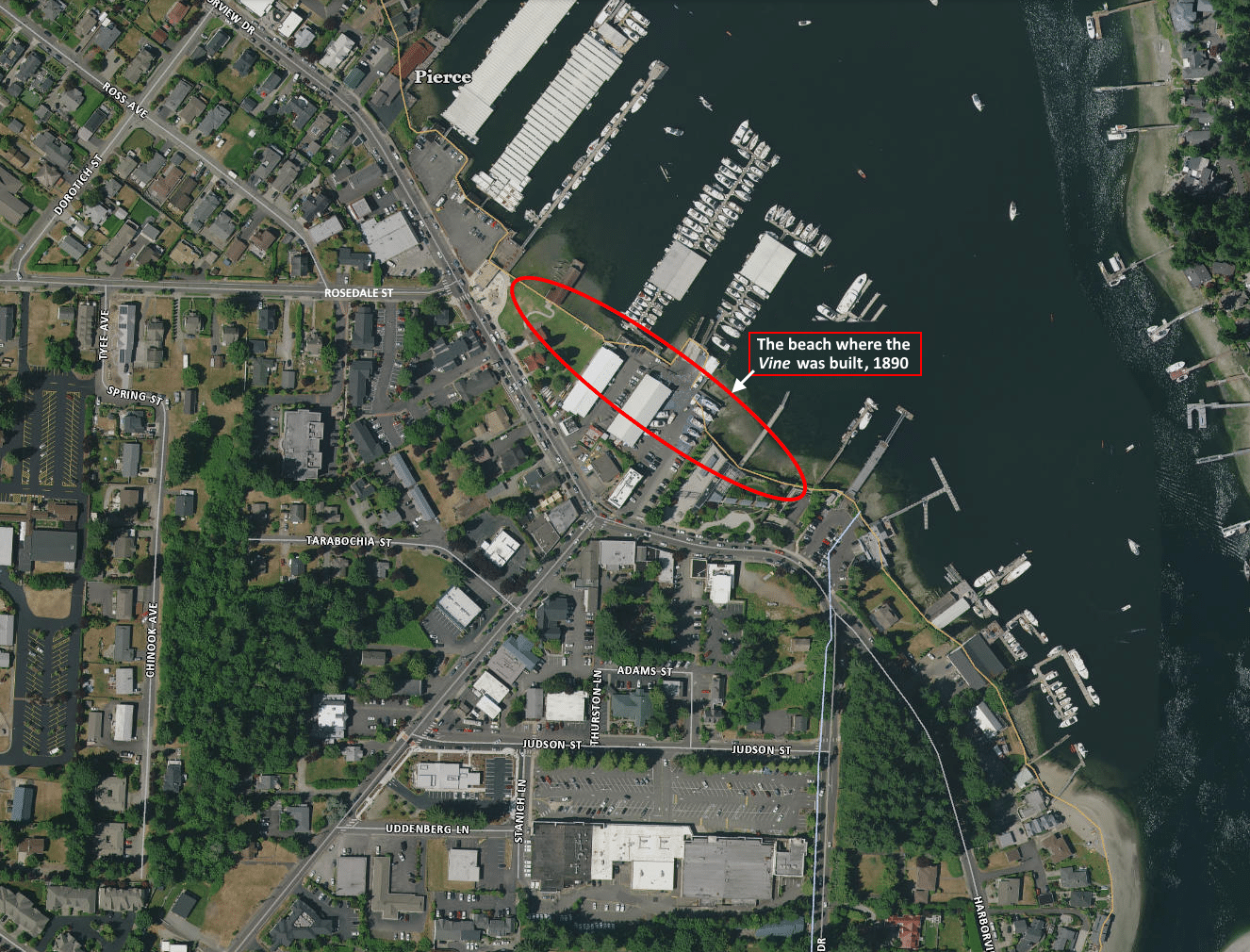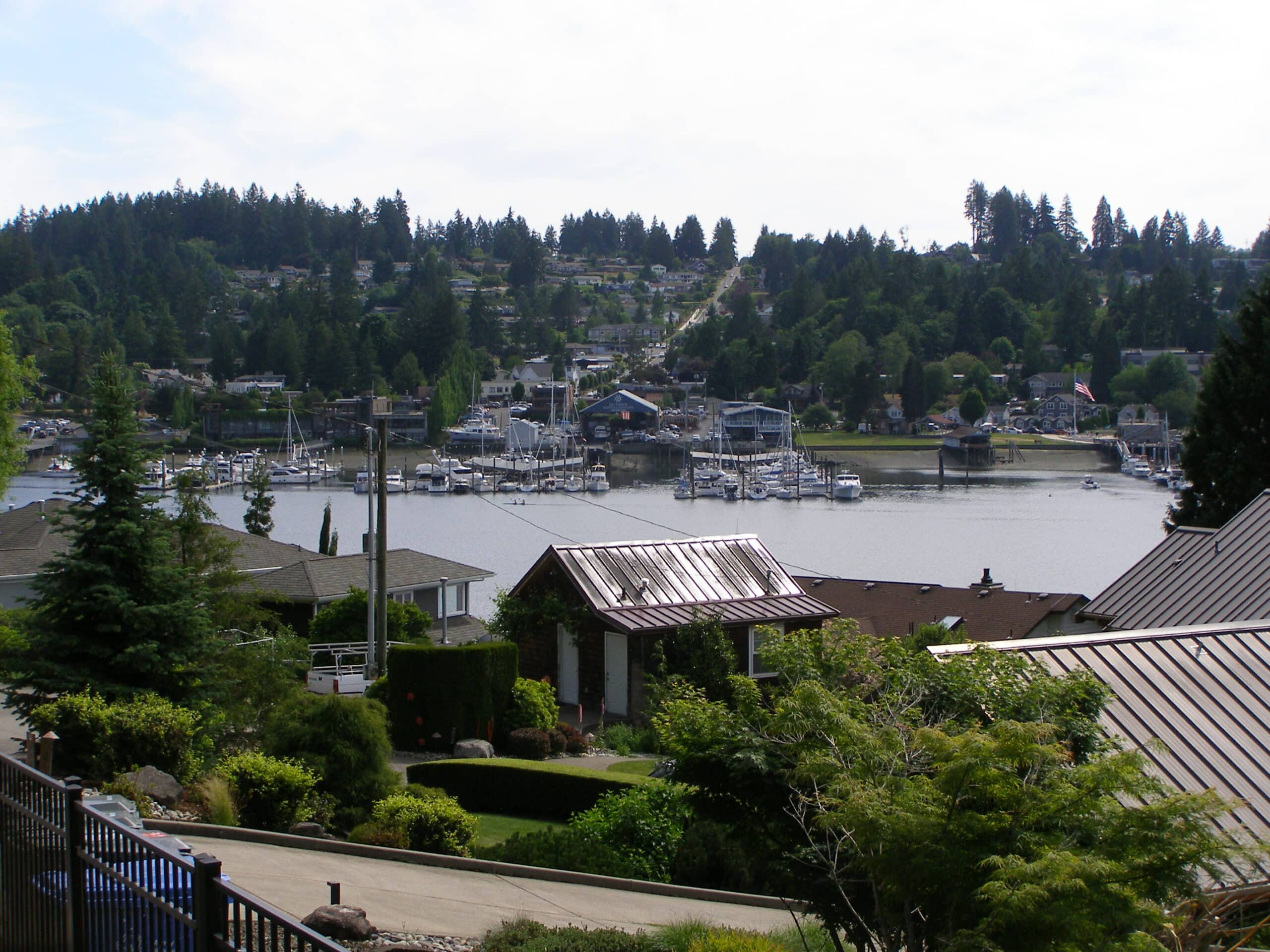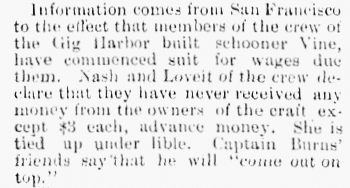Community
Gig Harbor Now and Then: The Vine, government land and unpaid sailors
Two weeks ago, the debut column of Gig Harbor Now and Then featured three questions of local history. All concern the schooner Vine, the second ship built in Gig Harbor. This week we provide the answers. They are as follows:
Community Sponsor
Community stories are made possible in part by Peninsula Light Co, a proud sponsor of Gig Harbor Now.

The Vine was built on the stretch of Gig Harbor beach that includes Skansie Brothers Park on the left end of the ellipse, the Gig Harbor Marina in the middle, and the Russell Family Foundation Building on the right. Pierce County Assessor-Treasurer aerial base map.
Question 1: Where in Gig Harbor was the Vine built?
Answer: The Gig Harbor Lumber Company, which built the Vine, had no shipyard. So the two-masted schooner was constructed on the beach in Gig Harbor, to the east of the company’s mill. That places the site along a stretch of the shoreline that includes the present locations of Skansie Brothers Park, the Gig Harbor Marina, and the Russell Family Foundation Building.

The schooner Vine was built on the beach somewhere along this stretch of Gig Harbor waterfront, ranging from the Russell Family Foundation Building on the left to the American flag flying at Skansie Brothers Park on the right. Photo by Greg Spadoni
Question 2: Who owned the land upon which the Vine was constructed?
Answer: The United States government. The Gig Harbor Lumber Company’s mill was on private property, but the land immediately to the east — beginning at the center of today’s Rosedale Street and running southeast to the mouth of the Harbor and then south all the way to Shore Acres — was part of U.S. Military Reservation #22 (of Washington Territory). It was not available for sale or homesteading at that time. The land had a number of squatters living on it in 1890, but they were all there illegally.
Question 3: What was the crew of the Vine‘s primary complaint upon arrival in San Francisco following its shakedown cruise?
Answer: That they had not been paid! The Vine crew was paid $3 in advance for the trip, to deliver Gig Harbor-milled lumber to California. They were promised $30 per month in salary. But Captain Burns, the belligerent skinflint that he was, had a habit of underpaying or not paying his crews, which led to labor problems throughout his ownership of the Vine.

The Tacoma Daily Times reported on the Vine’s labor problems during its very first voyage.
Did you get any of the answers correct? Were they too easy or too difficult?
Next question: A Gig Harbor Lumber Company home
Today we have only one new question. It’s rated a reasonable 2 out of 5 on our degree-of-difficulty scale.
It concerns Gig Harbor two years before the Vine was built. Once again, it involves the Gig Harbor Lumber Company, but instead of a schooner on the water, the focus is on dry land … well, most of the time, anyway.
The beginning of the development of Gig Harbor is widely credited to Dr. Alfred Burnham’s platting of the City of Gig Harbor in 1888. That credit is misplaced, however.
Burnham’s platting of the town site was in reaction to the selection of the little bay for the location of a world-class lumber mill by Frank Hall, which was the true catalyst. Dr. Burnham was indeed a very important and influential figure in the area’s early history, but it was Frank Hall’s vision that led to Gig Harbor becoming the center of business on the greater Peninsula.
The Gig Harbor Lumber Company, of which Frank Hall was president and a major investor, began cutting lumber in 1888 immediately to the north of the foot of today’s Rosedale Street, on the west shore of Gig Harbor. Nearly all of its production was shipped out of state, to California, New England, South America, Europe, China, and the South Pacific. Very little was sold locally.
In fact, there is only one remaining building known to have been constructed with Gig Harbor Lumber Company lumber, a house built in Gig Harbor in 1888. Where is that house located?
How it works
Do you know the answer to today’s question? Can you find the answer? I think maybe you can. It’s somewhere online; I uploaded it myself a year or two ago.
Gig Harbor Now and Then will have the answer two weeks from today. In the meantime, you’re invited to visit the Gig Harbor Now Facebook page and post your guess and other thoughts about today’s question, and read what others have to say about it. Comments on the three answers given today are also welcomed.
Be aware that if today’s question turns out to be too easy, the degree of difficulty will be turned up next time. There are three higher notches on the Wheel of Difficulty, and I’m not afraid to use them.
Greg Spadoni of Olalla has had more access to local history than most life-long residents. During 25 years in road construction working for the Spadoni Brothers, his first cousins, twice removed, he traveled to every corner of the Gig Harbor and Key Peninsulas, taking note of many abandoned buildings, overgrown farms, and roads that no longer had a destination. Through his current association with the Harbor History Museum in Gig Harbor as the unofficial Chief (and only) Assistant to Linda McCowen, the Museum’s primary photo archive volunteer, he regularly studies the area’s largest collection of visual history. Combined with the print history available at the Museum and online, he has uncovered countless stories of long-forgotten local people and events.


